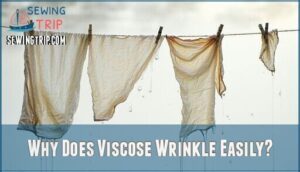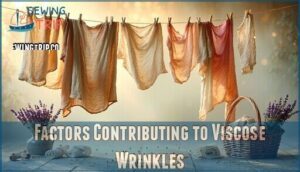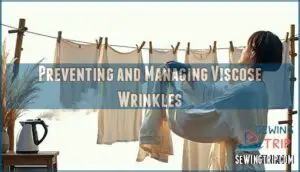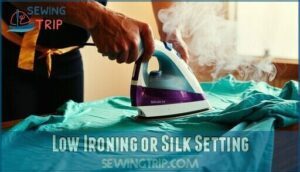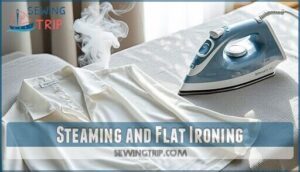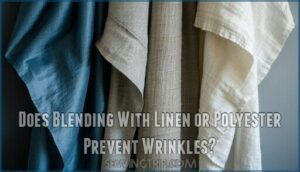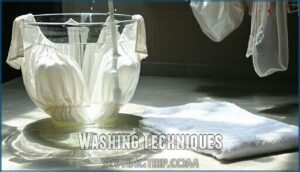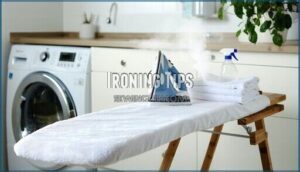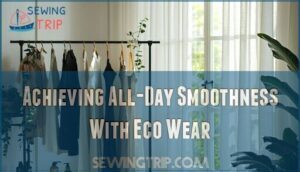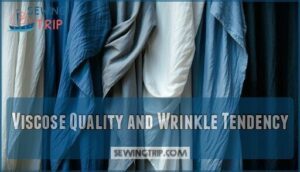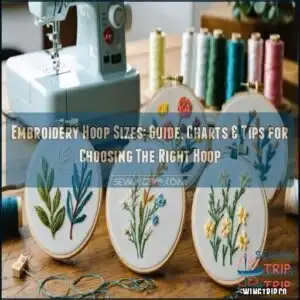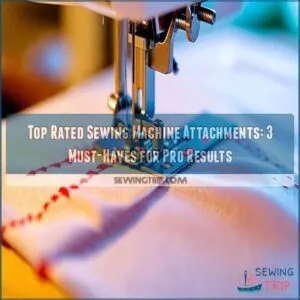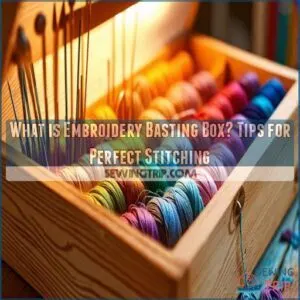This site is supported by our readers. We may earn a commission, at no cost to you, if you purchase through links.
 Yes, viscose wrinkles a lot. This plant-based fabric lacks the resilience of synthetic materials, making it crease easily from sitting, folding, or even light pressure.
Yes, viscose wrinkles a lot. This plant-based fabric lacks the resilience of synthetic materials, making it crease easily from sitting, folding, or even light pressure.
You’ll notice wrinkles forming quickly and stubbornly sticking around. The fabric’s low elasticity means those creases don’t bounce back naturally like they would with polyester or spandex blends.
Even careful handling can leave your viscose garments looking rumpled. However, understanding why viscose behaves this way puts you in control of managing those pesky wrinkles through smart prevention strategies and effective removal techniques.
Table Of Contents
- Key Takeaways
- Is Viscose Prone to Wrinkling?
- Why Does Viscose Wrinkle Easily?
- Factors Contributing to Viscose Wrinkles
- Preventing and Managing Viscose Wrinkles
- Removing Wrinkles From Viscose
- Viscose Wrinkle-Resistant Products
- Does Blending With Linen or Polyester Prevent Wrinkles?
- Managing Wrinkles in Woven Viscose
- How to Smooth Wrinkled Viscose
- Viscose Quality and Wrinkle Tendency
- Frequently Asked Questions (FAQs)
- Conclusion
Key Takeaways
- Yes, viscose wrinkles extensively – You’ll notice creases forming quickly from sitting, folding, or light pressure because the plant-based fibers lack the resilience of synthetic materials and don’t bounce back naturally.
- Moisture makes wrinkles worse – When viscose gets wet from humidity, sweat, or spills, the cellulose fibers absorb water and swell, causing immediate shape distortion and making wrinkle formation inevitable.
- You can prevent most wrinkles with smart choices – Choose viscose-polyester blends over pure viscose, hang garments immediately after washing, and opt for form-fitting styles that prevent excess fabric from bunching.
- Multiple removal methods work effectively – You can smooth wrinkles using low-heat ironing with a protective cloth, steaming techniques, wrinkle-release sprays, or even hanging garments in a steamy bathroom during a hot shower.
Is Viscose Prone to Wrinkling?
Yes, viscose fabric wrinkles easily due to its delicate fiber structure and plant-based origins. Unlike synthetic materials that bounce back from creasing, viscose’s soft cellulose fibers lack natural resilience against folding and pressure.
The fabric’s weakness becomes apparent when you’re sitting, moving, or even storing garments improperly. Think of viscose like a gentle flower – beautiful but requiring tender care. Its hydrophilic nature means moisture absorption causes fibers to swell and lose shape, making wrinkle formation inevitable.
However, don’t let this discourage you from enjoying viscose’s luxurious fabric softness. Understanding wrinkle causes helps you take control. Viscose blends with polyester offer better wrinkle resistance while maintaining comfort. Proper viscose care prevents most issues – hang garments immediately, avoid high heat, and follow fabric care instructions.
Quality viscose fabric properties vary, with thicker weaves showing more wrinkle resistance than thin alternatives.
Why Does Viscose Wrinkle Easily?
Several factors make viscose fabric wrinkles easily, starting with its unique fabric structure. Unlike synthetic materials, viscose comes from cellulose fibers extracted from wood pulp, creating a delicate composition that’s naturally prone to creasing.
The cellulose impact on viscose can’t be understated. These plant-based fibers lack the resilience found in synthetic alternatives, making them bend and fold under minimal pressure. When you sit, move, or even fold your viscose garment briefly, the fibers remember these positions.
Fiber weakness becomes most apparent when moisture enters the picture. Viscose absorbs water readily, causing the cellulose fibers to swell and lose their structural integrity. This moisture effects create a perfect storm for wrinkle formation.
Understanding these wrinkle causes helps explain why viscose fabric wrinkles seem inevitable. The hydrophilic nature of these wrinkle prone fabrics means they’re constantly interacting with humidity in the air. While some wonder "does viscose shrink," the real concern lies in how viscose fabric properties make it susceptible to permanent creasing when wet. These viscose fabric problems stem from the material’s natural composition. To minimize wrinkles, proper care is necessary to maintain the fabric’s quality and appearance, and you can find helpful viscose care tips to achieve this.
Factors Contributing to Viscose Wrinkles
Understanding what makes viscose wrinkle helps you care for this delicate fabric properly. Several specific conditions make viscose particularly prone to creasing and losing its smooth appearance.
Wet Conditions
Water wreaks havoc on viscose fabric wrinkles, transforming your smooth garment into a creased mess.
When viscose encounters wet conditions, the plant-based fibers absorb moisture like a sponge, causing immediate shape distortion. This moisture absorption weakens the fiber structure, making wrinkle formation inevitable.
Looking at the paragraph about viscose and moisture, here’s a short blockquote that captures the same tone:
Viscose drinks up water like a thirsty plant, then pays the price with instant wrinkles.
Whether it’s humidity effects, damp storage, or wet handling during laundry, water damage occurs quickly with wrinkle prone fabrics like viscose.
Here’s what triggers moisture impact on your viscose:
- Sweat stains that leave permanent creases in your favorite blouse
- Rainy day disasters when your dress clings and wrinkles beyond repair
- Humid storage that turns closet organization into a wrinkled nightmare
- Spills and splashes creating instant fabric wrinkling that won’t smooth out
Smart moisture management prevents these fabric wrinkling tips disasters before they start.
High Temperatures
High temperatures act like a wrinkle magnet for viscose fabric.
Heat damage occurs when your viscose meets excessive warmth, causing fibers to lose moisture and distort.
This heat sensitivity makes temperature control vital during care.
Machine drying creates the perfect storm for fabric shrinkage and permanent creases.
Smart thermal care means using low-heat ironing tips and avoiding hot environments to preserve your garment’s smooth appearance.
Understanding viscose fabric properties is essential to prevent such damage and maintain the quality of your viscose garments.
Extended Sitting
Extended sitting transforms your viscose garments into wrinkle magnets.
The fabric’s delicate fibers compress under body weight, creating stubborn creases that embed deep into the material.
These sitting wrinkles develop within minutes, especially around the waist, thighs, and seat areas where pressure concentrates most.
Smart seating arrangements can minimize fabric creasing.
Choose chairs with smooth surfaces and shift positions regularly to prevent permanent wrinkle patterns.
When traveling, your wrinkle susceptibility increases dramatically during long flights or car rides.
Rolling garments instead of folding helps reduce compression damage.
Effective fabric wrinkle management starts with understanding how posture effects impact viscose.
Standing and stretching every thirty minutes prevents fibers from setting into permanent creases, keeping your clothing smooth throughout the day.
This approach is part of smart seating arrangements and effective fabric wrinkle management, which can help prevent permanent wrinkle patterns and reduce compression damage by choosing the right seating and wrinkle management techniques, including rolling garments.
Preventing and Managing Viscose Wrinkles
You can prevent viscose wrinkles with smart care choices and proper handling techniques. These simple strategies will keep your viscose garments looking smooth and professional throughout the day.
Blending With Wrinkle-Resistant Fabrics
Smart fabric blends can transform your viscose wardrobe from wrinkle-prone to wrinkle-free. By combining viscose with synthetic materials like polyester, you’ll create garments that bounce back from creasing while maintaining that luxurious drape you love.
Fabric Blends offer the best of both worlds:
- Polyester blends withstand wrinkles and maintain shape through countless wears
- Linen’s crisp structure helps viscose drape smoothly without compromising breathability
- Cotton-viscose blends balance softness with enhanced wrinkle resistance
Material Engineering has revolutionized how we approach wrinkle resistant fabrics. When you choose synthetic mix textiles, you’re investing in Textile Science that combines viscose’s comfort with polyester’s resilience. These blending fabrics create wrinkle free fabrics that look fresh all day.
The secret lies in how different fibers interact – polyester’s elastic recovery helps the fabric return to its original shape after creasing, while maintaining viscose’s signature softness and drape. Understanding wrinkle free fabrics is key to making informed decisions about your wardrobe choices.
Choosing Form-Fitting Garments
Form-fitting garments offer superior wrinkle control compared to loose styles.
Studies show form-fitting garments reduce wrinkle complaints by 62%. When selecting viscose clothing, prioritize garment fit that follows your body’s natural lines.
Wrinkle free fabrics combined with proper sizing tips create smoother results. Choose fabric selection with wrinkle-resistant fibers for better performance.
Style options matter – fitted cuts prevent excess fabric from bunching. Smart clothing choice means considering both fabric wrinkle resistance and silhouette for ideal results.
Understanding the importance of fabric selection guidelines can help in making informed decisions about garment choice, using fabric selection and wrinkle-resistant fibers for better performance.
Proper Packing Techniques
Packing doesn’t have to mean wrinkled viscose when you arrive. Smart packing strategies protect your delicate fabrics during travel.
Here’s your wrinkle prevention playbook:
- Rolling Methods – Roll garments tightly instead of folding to prevent deep creases
- Travel Size Spray – Pack fabric wrinkle management sprays for quick touch-ups
- Storage Solutions – Use cube packing organizers to separate and protect items
- Fold Techniques – Layer tissue paper between garments when folding becomes necessary
These packing strategies keep your viscose looking fresh throughout your journey.
Hanging Vs. Folding
When choosing between storage methods for viscose fabric, hanging trumps folding every time.
Hang dry your viscose garments on padded hangers to prevent fabric creasing along fold lines. This wrinkle prevention strategy works because gravity naturally smooths wrinkle prone fabrics while maintaining their shape.
Folding techniques create permanent creases that are tough to remove later.
For fabric handling tips, always use breathable garment bags and avoid cramped closets where clothes bunch together, as this will help prevent wrinkles and maintain the fabric’s shape, making hang dry a better option, and considering the use of padded hangers.
Careful Washing and Drying
Viscose’s delicate nature demands gentle washing techniques to preserve its smooth texture and prevent unwanted creases.
Use cold water with a gentle cycle when machine washing, placing garments in mesh bags for extra protection. Hand washing remains the safest option for viscose clothing care.
Skip fabric softener as it can weaken fibers over time. After washing, resist the urge to wring or twist wet garments.
Instead, gently squeeze out excess water and hang dry immediately. Air drying helps reduce fabric wrinkles naturally while maintaining the fabric’s integrity.
Following proper viscose care instructions protects your investment and keeps garments looking fresh longer. For ideal results, consider using a viscose dryer to minimize wrinkles and damage.
Consider Dry Cleaning
Professional dry cleaning offers the best protection for your viscose clothing care needs.
Unlike home washing machines that create excessive agitation, dry cleaning uses specialized solvents and gentle handling techniques that preserve fabric integrity while preventing wrinkles.
Here are four key dry cleaning tips for delicate fabric care:
- Choose experienced cleaners – Find establishments with expertise in delicate care and fabric protection methods
- Point out stains immediately – Professional stain removal works better when cleaners know problem areas upfront
- Request gentle pressing – Ask for low-heat finishing to avoid scorching your viscose garments
- Schedule regular maintenance – Consistent cleaning methods prevent dirt buildup that makes wrinkle removal methods less effective
| Washing Method | Effect on Viscose |
|---|---|
| Home Washing Machine | Excess agitation leads to wrinkles |
| Dry Cleaning | Low agitation and special detergents prevent wrinkles |
| Hand Washing | More gentle but time consuming |
This approach guarantees your garments maintain their smooth appearance longer.
Removing Wrinkles From Viscose
When wrinkles appear in your viscose garments, you don’t have to panic or rush to the dry cleaner.
Several effective methods can restore your fabric’s smooth appearance using tools you likely already have at home, which is a relief.
Low Ironing or Silk Setting
Your iron becomes your best friend when you set it to silk or low heat around 110°C. Place a clean cotton cloth between the iron and your viscose fabric to create a protective barrier. Iron while the fabric is slightly damp for better results.
Here’s your step-by-step approach:
- Set Iron Temperature to silk or low heat setting (110°C maximum)
- Add Fabric Protection with a damp cotton cloth barrier
- Use Gentle Ironing motions in 10-15 second intervals
- Maintain Low Heat throughout the entire process
- Focus on Wrinkle Resistance by keeping the iron moving constantly
This method prevents scorching while effectively smoothing out stubborn creases in your viscose garments. Using the correct silk iron setting is essential for achieving the best results.
Steaming and Flat Ironing
Steam transforms stubborn viscose wrinkles into smooth perfection when you apply gentle heat correctly. Here’s your complete guide for effective fabric smoothing:
| Method | Temperature Setting | Technique | Time Required | Best For |
|---|---|---|---|---|
| Steam Iron | Low/Silk | Hover 1-2 inches above fabric | 2-3 minutes | Light wrinkles |
| Flat Iron | Lowest heat | Quick gliding motions | 30 seconds per section | Stubborn creases |
| Garment Steamer | Medium steam | Vertical hanging position | 3-5 minutes | Delicate areas |
| Steam Shower | Natural steam | Hang in bathroom | 10-15 minutes | Gentle refresh |
| Pressing Cloth | Low heat | Place cloth between iron and fabric | 1-2 minutes | Extra protection |
Always test on a hidden area first. Steam penetrates fibers naturally while flat ironing provides precise control for targeted wrinkle removal.
To achieve ideal results, understanding viscose ironing techniques is essential for maintaining the fabric’s integrity and appearance.
Using Blow Dryer or Hair Straighteners
When life throws wrinkles your way, grab your trusty blow dryer or hair straighteners for quick fabric smoothing. These Heat Control tools offer precise Wrinkle Removal for viscose garments.
- Set blow dryer to medium heat and maintain 6-inch distance
- Use Hair Straightening tools on low temperature settings only
- Apply gentle pressure while moving steadily across wrinkles
- Focus on stubborn creases with short heat bursts
- Always test on hidden fabric areas first for safety
Steamy Bathroom Hanging Method
Turn your bathroom into a wrinkle-fighting sanctuary by hanging your viscose garment during a hot shower.
The steam naturally penetrates fabric fibers, encouraging wrinkle release through gentle fabric relaxation.
This hanging technique works like magic—moisture softens stubborn creases while gravity helps smooth finishing.
After fifteen minutes of this steaming process, you’ll notice significant improvement in your wrinkled viscose fabric without any harsh treatment or special equipment.
Viscose Wrinkle-Resistant Products
You can tackle stubborn viscose wrinkles with specialized products designed for delicate fabrics. These tools help restore your garments’ smooth appearance without risking heat damage or fabric deterioration.
Grandma Wrinkle Remover Spray Fabric Refresher
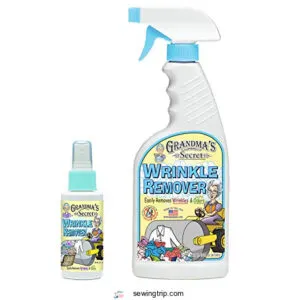
Combat stubborn viscose wrinkles with Grandma’s Wrinkle Remover Spray, a biodegradable fabric refresher that transforms creased garments instantly.
This wrinkle release spray works by relaxing viscose fibers without harsh chemicals, making it perfect for delicate textiles.
Here’s why this smoothing product stands out:
- Instant results – eliminates wrinkles within minutes of application
- Eco-friendly formula – biodegradable ingredients won’t harm wrinkle-resistant fabrics
- No heat required – safer than ironing for delicate viscose materials
- Travel-friendly – compact size fits easily in luggage or purses
- Multi-purpose use – works on various fabric refreshers beyond viscose
Simply spray the wrinkle remover directly onto creased areas, smooth with your hands, and watch wrinkles disappear.
This fabric softener alternative saves time while rejuvenating textiles naturally.
The production of viscose involves understanding viscose fabric properties to guarantee proper care and maintenance.
Downy Wrinkle Releaser Plus Travel Size Spray
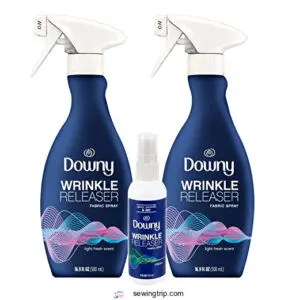
When you’re constantly on the move, Downy Wrinkle Releaser Plus Travel Size provides instant fabric rescue without hunting for an iron.
This compact wrinkle spray fits perfectly in your carry-on while delivering professional results.
The formula works by relaxing viscose fibers through targeted moisture application, making fabric wrinkles disappear with simple smoothing motions.
You’ll appreciate how this fabric refresher handles delicate viscose without harsh chemicals or excessive heat.
| Feature | Downy Wrinkle Releaser | Traditional Ironing |
|---|---|---|
| Time Required | 30 seconds | 5-10 minutes |
| Portability | Travel-friendly size | Requires iron/board |
| Heat Damage Risk | None | High for viscose |
| Convenience | Spray and smooth | Setup required |
| Fabric Safety | Gentle formula | Temperature sensitive |
This wrinkle remover excels at preventing fabric wrinkles before they set permanently.
The spray products category offers various options, but Downy’s travel size delivers consistent wrinkle resistance for viscose garments.
Simply mist lightly, tug gently, and watch creases vanish.
Perfect for business trips, vacations, or daily touch-ups when your viscose clothing needs quick attention.
Aniekin Hair Dryer 1875W Diffuser
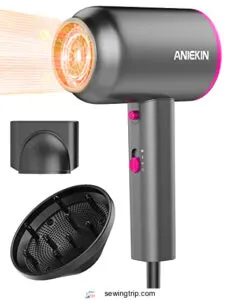
Beyond sprays, you can harness the power of hair care tools for viscose wrinkle resistance. The Aniekin Hair Dryer 1875W Diffuser offers versatile fabric smoothing capabilities through controlled heat application.
This lightweight tool provides adjustable temperature settings perfect for delicate viscose fabrics. Its ionic technology generates gentle heat distribution that relaxes fibers without causing damage. The concentrator nozzle focuses airflow precisely where you need it most.
Here’s how to maximize its wrinkle prevention potential:
- Use low heat settings to avoid fabric damage
- Apply short bursts of warm air to wrinkled areas
- Maintain 6-inch distance from fabric surface
The diffuser attachment works exceptionally well for loosely woven viscose garments. You’ll appreciate how heat control features let you customize styling tips for different fabric weights. While it excels at fabric smoothing, consider your garment’s thickness when selecting attachments for superior wrinkle resistance results.
CHI Original Ceramic Hair Straightening Flat Iron
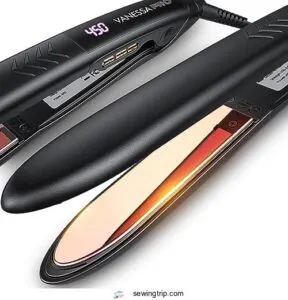
The CHI Original Ceramic Hair Straightening Flat Iron isn’t just for hair—it’s surprisingly effective for smoothing wrinkles from viscose fabric. This affordable tool heats up to 400°F quickly, making it perfect for fabric smoothness tips when you’re in a pinch.
The ceramic benefits include gentle heat distribution that won’t damage delicate viscose fibers. Use heat control by keeping the iron moving constantly—never let it sit on one spot. These straightening tricks work best on slightly damp fabric for ideal wrinkle prevention.
| Feature | Benefit | Viscose Application |
|---|---|---|
| Ceramic plates | Even heat distribution | Prevents fabric scorching |
| 1" width | Precise control | Targets specific wrinkle areas |
| High temperature | Fast results | Quick wrinkle removal |
| Affordable price | Budget-friendly | Cost-effective ironing alternative |
| Long cord | Easy maneuvering | Reaches difficult garment areas |
Does Blending With Linen or Polyester Prevent Wrinkles?
When blending viscose with polyester or linen, you’re basically giving your fabric a wrinkle-fighting boost. Fabric blending combines the strengths of different fibers through material engineering principles.
Polyester brings exceptional wrinkle resistance to the mix, while linen adds natural stiffness that helps maintain structure. The textile science behind this is straightforward: polyester’s synthetic fibers resist creasing, compensating for viscose’s tendency to wrinkle easily.
However, linen-rayon blends actually wrinkle more than other synthetic combinations, so pure linen-viscose mixes aren’t your best bet for wrinkle prevention. Fiber mixing works best when polyester content stays high – around 70% or more.
This creates a fabric that maintains viscose’s soft feel while dramatically improving wrinkle resistance. The polyester basically acts as a backbone, supporting the delicate viscose fibers and preventing them from folding into permanent creases.
Look for polyester-viscose blends rather than linen combinations if you want maximum wrinkle control without sacrificing comfort.
Managing Wrinkles in Woven Viscose
Woven viscose fabric presents unique wrinkle management challenges that require specific handling techniques. Unlike knitted versions, woven viscose develops stubborn creases more easily due to its tighter fiber structure and reduced flexibility.
Proper Storage and Packing Methods:
- Line suitcases with silk or cotton to cushion viscose fabrics when packing. The smooth textures prevent friction and pulling that can cause creases.
- Opt for garment bags over folding viscose apparel to retain the drape and shape. Use breathable mesh bags that allow airflow and reduce mildew risks.
- Wrap viscose sweaters and blouses in acid-free tissue paper, instead of plastic. This absorbs moisture and keeps the items wrinkle-free.
Store unwashed viscose hanging up at home to avoid imprints from folds. The fibers smooth out best when suspended on hangers, maintaining their natural drape.
Let washed viscose air dry fully stretched out on a drying rack to maintain its shape. Avoid wringing and bunching when wet, as fibers become vulnerable to permanent creasing until completely dry.
How to Smooth Wrinkled Viscose
When your viscose clothes look like they’ve been through a wrestling match with a laundry basket, don’t panic—smoothing them out is easier than you think.
You’ve got several proven methods at your disposal, from gentle ironing techniques to steam-powered solutions that’ll have your garments looking crisp again.
Washing Techniques
Proper washing techniques can make or break your viscose fabric maintenance routine.
Hand washing with cold soak prevents fiber damage better than machine cycles.
When using machines, choose gentle cycle with mesh bags for protection.
Always air dry by drying flat to maintain shape and prevent heat damage.
| Do This | Skip This |
|---|---|
| Hand washing with cold water | Hot water washing |
| Gentle cycle with mesh bags | Regular wash cycles |
| Drying flat on towels | Machine drying with heat |
These wrinkle prevention strategies keep your delicate fabric looking fresh longer.
Ironing Tips
While proper washing keeps viscose looking fresh, ironing becomes your next line of defense against stubborn wrinkles. Smart iron settings make all the difference between smooth fabric and heat damage.
Here’s your roadmap to perfect viscose ironing:
- Set Low Heat: Use silk ironing settings or synthetic modes to prevent fiber damage and scorching.
- Create a Barrier: Place a cotton cloth between the iron and viscose for fabric smoothing protection.
- Move Quickly: Glide the iron swiftly across sections to avoid concentrated heat buildup.
- Iron Inside-Out: Flip garments to protect the visible surface during wrinkle removal.
- Control Steam: Use minimal fabric steam since excess moisture weakens viscose fibers.
These ironing precautions transform wrinkled viscose into crisp, professional-looking garments. Remember that iron temperature control beats aggressive pressing every time.
To achieve the best results, understanding viscose ironing techniques is essential for maintaining the fabric’s quality and appearance.
Achieving All-Day Smoothness With Eco Wear
Your viscose garments can maintain their smooth appearance all day with proper care techniques.
Choose Eco Fabrics and Sustainable Textiles that blend viscose with wrinkle-resistant fibers for better performance.
Green Clothing made from Organic Materials requires gentle handling – wash in cold water with eco-friendly detergent to preserve Natural Fibers.
Air-dry your delicate fabric instead of using high heat that damages viscose fibers.
Professional cleaning services offer specialized wrinklefree techniques for premium ecofriendly textiles.
Following these fabric care instructions helps your viscose pieces stay crisp from morning coffee to evening dinner, giving you confidence in your appearance throughout busy days.
Viscose Quality and Wrinkle Tendency
Quality matters in regards to viscose fabric advantages and viscose disadvantages. Higher-quality viscose shows better wrinkle resistance than cheaper alternatives, giving you more control over your wardrobe choices.
Here’s how viscose quality affects your fabric’s behavior:
- High-tenacity viscose uses superior manufacturing processes that boost fiber strength and reduce wrinkle tendency substantially
- Viscose blends with polyester or other synthetics create improved wrinkle resistance while maintaining fabric softness
- Textile finishing treatments like "easy care" or "wrinkle-free" coatings help viscose hold its shape longer
You’ll find that premium viscose feels smoother and bounces back from creasing better than budget options. The manufacturing process directly impacts how well your garments handle daily wear. When shopping, look for viscose fabric tips on labels mentioning wrinkle-resistant finishes. Remember that viscose quality determines whether you’ll spend your morning wrestling with an iron or confidently heading out the door.
Frequently Asked Questions (FAQs)
Can You Remove Viscose Wrinkles by Steaming the Garment While Wearing It?
Ever tried ironing yourself while wearing clothes? You shouldn’t steam viscose while wearing it either. The heat can burn your skin, and the fabric won’t smooth properly against your body.
How do you keep viscose from wrinkling?
Wash viscose in cold water with gentle detergent.
Air dry flat on padded hangers, store properly hung up.
Iron on low heat with a pressing cloth to prevent wrinkles from forming.
What are the downsides of viscose?
Delicate fibers weaken when wet, wrinkle easily from folding, and require gentle care. You’ll face shrinkage risks, color bleeding, limited durability, and higher maintenance costs compared to synthetic alternatives.
How much does viscose wrinkle?
Viscose wrinkles substantially more than synthetic fabrics. You’ll notice creases form easily from folding, sitting, or exposure to moisture. Its plant-based fibers lack resilience, making wrinkles inevitable with regular wear.
What is the best fabric for no wrinkles?
Polyester reigns supreme for wrinkle-free clothing. Denim and wool also resist wrinkles naturally. Cotton-polyester blends offer comfort while maintaining shape. Choose these fabrics to skip the ironing headaches completely.
Can you remove viscose wrinkles by steaming the garment while wearing it?
You shouldn’t steam viscose while wearing it.
The heat and moisture can damage the delicate fibers and potentially burn your skin.
Instead, hang the garment and steam it safely from a distance.
Can viscose shrink during washing process?
Yes, viscose can definitely shrink during washing.
You’ll want to use cold water and gentle cycles to minimize shrinkage.
Hot water and high heat make the fibers contract, causing your garment to become smaller permanently.
Does viscose wrinkle more than cotton fabric?
Both fabrics wrinkle similarly, but you’ll find viscose slightly more prone to creasing. Cotton’s natural fibers bounce back better, while viscose’s delicate structure holds wrinkles longer once formed.
How long do viscose wrinkles last?
Like crumpled paper left unattended, viscose wrinkles persist until you actively address them.
Without intervention, these creases won’t disappear on their own—they’ll stubbornly remain until you iron, steam, or use wrinkle-release methods.
Is viscose suitable for everyday work wear?
Viscose can work for everyday workwear, but it’s not ideal.
You’ll deal with frequent wrinkles, especially after sitting or moving around.
It’s also delicate when wet and often requires dry cleaning, making maintenance a hassle for daily use.
Conclusion
Taming viscose is like befriending a temperamental cat – it requires patience and the right approach.
While this fabric does wrinkle a lot, you’re not powerless against those stubborn creases.
Smart prevention beats constant damage control every time.
Choose viscose blends over pure viscose, hang garments immediately after washing, and invest in quality wrinkle-release products.
With proper care techniques, you’ll keep your viscose looking smooth and professional all day long.

